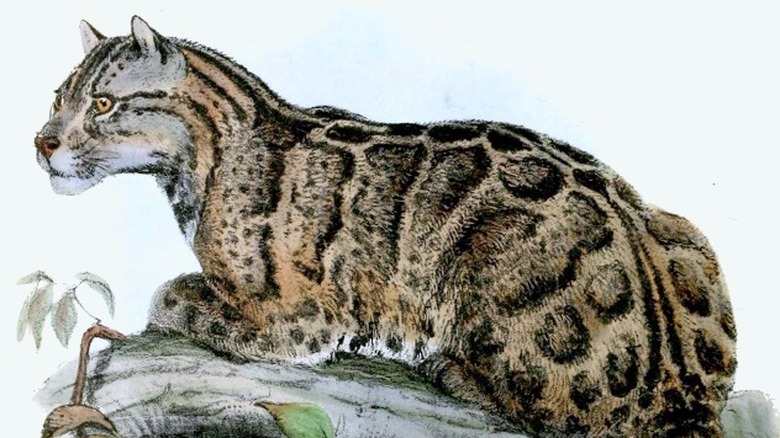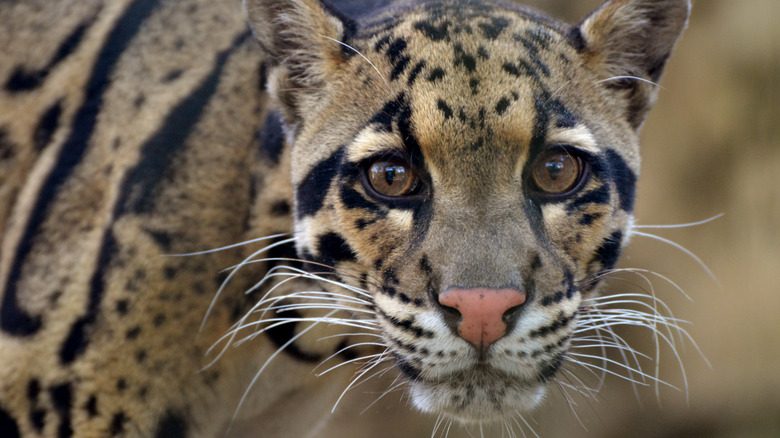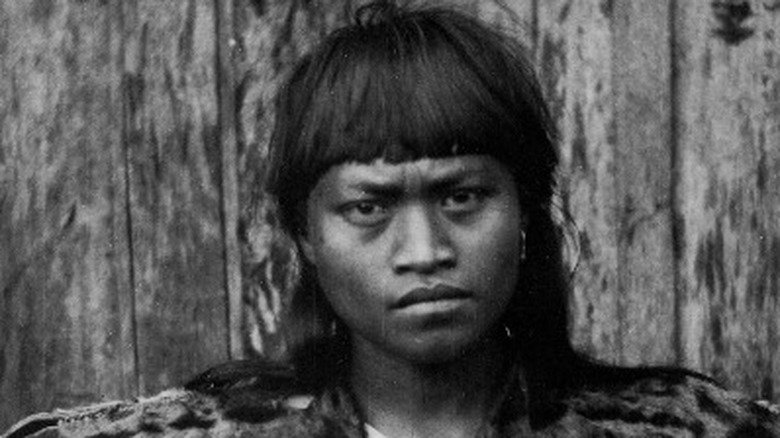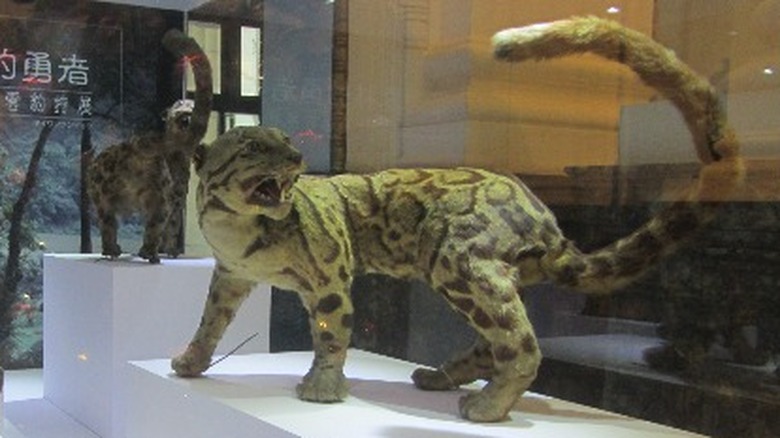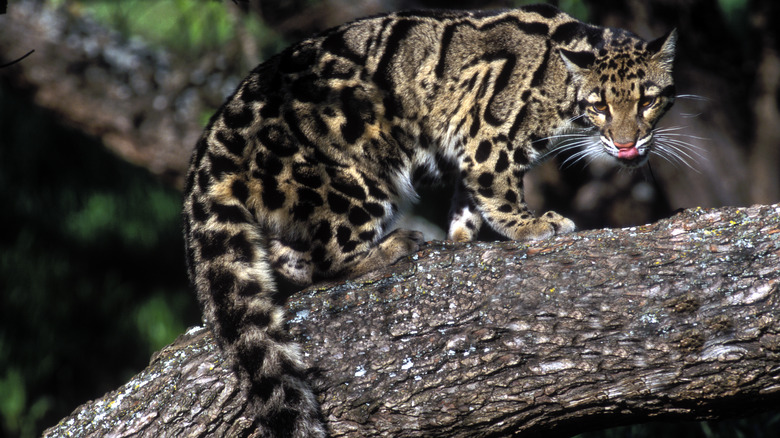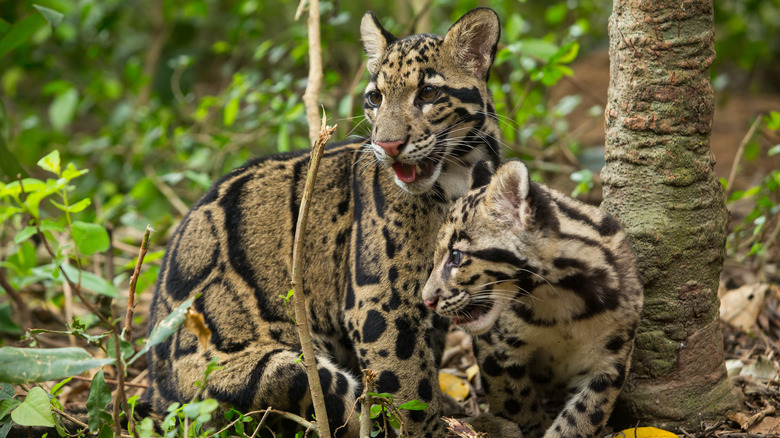Meet The Formosan Clouded Leopard: The Animal That Was Once Believed Extinct
As we enter what scientists say is a sixth mass extinction driven by human activity, there is no shortage of tragic stories of plants or animals that have disappeared from the Earth. Yet sometimes, death releases its grip, and a creature thought lost turns out to have merely been hiding. This was the case of the Formosan clouded leopard, a unique and elusive population of feline that roams the forests of Taiwan, according to One Earth. The Formosan clouded leopard — known as Li' uljaw in the local Indigenous Paiwan language — was declared extinct in 2013 after scientists spent years trying to film one in the wild, according to Taiwan News. However, this declaration was thrown into doubt when several villagers claimed to have seen one in 2018. Before that, the last official sighting was in 1983, but for National Taitung University Department of Life Science Professor Liu Chiung-hsi, the village sightings were a valid reason to hope that this skittish cat is still with us. "I believe this animal still does exist," Chiung-hsi said (via Yahoo News).
The Formosan clouded leopard is especially unique for its tree-climbing abilities: It is one of the only cats that can descend a tree face first, according to One Earth. "They are phenomenal athletes. They can climb like no cat I've ever seen," Clouded Leopard SSP Coordinator and International Studbook Keeper for the Association of Zoos and Aquariums Bonnie Breitbeil said. It's good to know that arboreal prowess isn't lost.
A leopard that's not a leopard
The Formosan clouded leopard, like all clouded leopards, isn't really a leopard at all, according to One Earth. Scientifically, the famous big cats — tigers, lions, jaguars, and leopards — are classified under the genus Panthera, according to the New World Encyclopedia. However, clouded leopards actually belong to the genus Neofelis. There are two species of clouded leopards: Neofelis nebulosa, which lives in mainland Asia; and Neofelis diardi, which lives in Sumatra and Borneo. The Formosan clouded leopard was once considered a separate subspecies unique to Taiwan — Neofelis nebulosa brachyura — but now scientists believe it is simply a different population of Neofelis nebulosa (via IUCN).
Clouded leopards got their name because of their cloud-like spots, according to the San Diego Zoo Wildlife Alliance. Size-wise, they are around 26 to 41 inches long, with a shoulder height of 10 to 16 inches and a tail of 24 to 33 inches. "They have a stocky build and are larger than small cats and smaller than the large cats!" the zoo wrote. However, they have some interesting features. The males can be more than double the size of the females, which is the biggest sex size difference of all cat species. Also, you don't want to be on the wrong end of their teeth — their canines are longer relative to their body size than the canines of any other species in the cat family.
Appearance and disappearance
The Formosan clouded leopard is got its non-scientific, English name from an old appellation for the island of Taiwan. Portuguese sailors passing the island in the 16th century were so impressed with the scenery that they called it "Ilha Formosa," or "Beautiful Island," and the name stuck, according to Culture Trip. The cat was first described in 1862 in "On the Mammals of the Island of Formosa" by Robert Swinhoe. Swinhoe thought it was a distinct species because he had seen two or three skins with shortened tails. However, a 2006 study concluded that Swinhoe had likely been looking at specimens whose tails were shortened after the fact (via Current Biology). Swinhoe described the cat as a nocturnal hunter that avoided humans but "committ[ed] great havoc among the Deer."
The Formosa clouded leopard was right to hide. Poaching, deforestation, the eradication of its prey, and high demand for its pelts from Japanese soldiers during that country's occupation of Taiwan from 1895 to 1945 all brought it to the brink of extinction during the 20th century, according to Scientific American and "The Clouded Leopard in Taiwan." Per the latter source, scientists writing in the late 1960s said its population was at "dangerously low levels." When conservationist Dr. Alan Rabinowitz visited Taiwan in 1986 and surveyed Indigenous hunters, forest workers, and rural villagers about sightings of the cats, he found that 23 out of 33 of them were more than 10 years old, and the most recent was from 1983.
Declared extinct
After Dr. Alan Rabinowitz's survey, researchers made more efforts to prove that the Formodan clouded leopard was still out there. A photograph taken in 1983 showed a Formosan clouded leopard at the bottom of a pit, according to Scientific American. However, doubt was cast on the authenticity of this image. Its negative vanished, and experts said that Indigenous Taiwanese hunters preferred snares to pits.
Beginning in 2001, a group of zoologists from the U.S. and Taiwan embarked on a 13-year project to lay around 1,500 infrared cameras and scent traps baited with catnip in forested, mountainous areas like Dawushan, Yushan, and Taroko National Park, according to Scientific American and the Taipei Times. Thirteen years later, not a single camera or trap had revealed evidence of the cats, leading the researchers to a heartbreaking conclusion: "There is little chance that the clouded leopard still exists in Taiwan," zoologist Chiang Po-jen told the Taipei Times. "There may be a few of them, but we do not think they exist in any significant numbers." The scientists feared that the only Formosan clouded leopard in the country was a stuffed specimen at the National Taiwan Museum.
Resurrection?
After the 2013 conclusion, it seemed the Formosan clouded leopard was locally extinct in Taiwan. However, five years later, some rangers from Alangyi Village in southeast Taiwan reported some exciting news, according to Taiwan News. In June 2018, Kao Cheng-chi — Paiwan village chief and president of the Association of the Austronesian Community College Development Association — told journalists that a group of rangers from the village had gone out on patrol,. While making their rounds, two groups said they saw Formosan clouded leopards. One ranger said that he saw a clouded leopard in a tree before it went to chase goats up a hillside. Another said one ran past a scooter and disappeared up a tree. Alangyi Village Conference Chairman Pan Chih-hua also verified the sightings to the press. The Taiwan News broke the story in February 2019.
The news prompted the villagers to take action to protect the survival of the animals they consider sacred. At a meeting, they decided to investigate the sightings further and ban other groups from hunting in the area. They also asked the Forestry Bureau to stop habitat-disturbing activities like logging. Taitung Forest District Office Deputy Director Huang Chun-tse also said the office wanted scientists to further investigate and confirm the cat's reemergence, according to Yahoo News.
Hope for the leopards
While the 2018 sightings do require more investigation, scientists think there is good reason to believe they are genuine. Liu Chiung-hsi said that the animals' tree-dwelling habits and skittish personalities make them difficult to spot and hunt, so it wasn't so surprising that they had remained off the radar for so long, according to Yahoo News and Taiwan News. He also told Taiwan News he had spoken to hunters in the late 1990s who confessed to successfully trapping the felines and burning the bodies to hide the evidence. Even if there are no more Formosan clouded leopards in Taiwan — or only an elusive few — the fact that they are the same species as mainland clouded leopards is cause for hope, as it would make it easier to reintroduce the species (per Africa Check).
Reclaiming more habitat for Neofelis nebulosa could only be a good thing for global biodiversity. The species is considered "Vulnerable" by the IUCN, and its numbers are falling, primarily because it lives in a part of Southeast Asia that is suffering some of the world's fastest rates of deforestation. It would also be good for Taiwan's local ecosystems. "A forest with clouded leopards and a forest without clouded leopards mean something different," zoologist Chiang Po-jen told Taiwan Review in 2013 (via Scientific American). "A forest without clouded leopards is ... dead."
